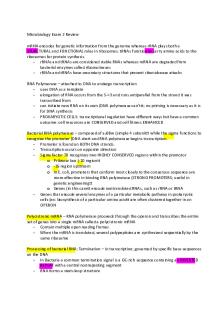BIO 211 Microbiology Exam 1 Review PDF

| Title | BIO 211 Microbiology Exam 1 Review |
|---|---|
| Author | Olivia Johnson |
| Course | Microbiology |
| Institution | Ivy Tech Community College of Indiana |
| Pages | 2 |
| File Size | 61.8 KB |
| File Type | |
| Total Downloads | 15 |
| Total Views | 172 |
Summary
Lecture Exam 1 review notes...
Description
BIO 211 Microbiology Exam 1 Review The test is 50 questions-- 35 multiple choice and 15 matching. 1. Know what part the early scientists played in the history of microbiology such as Pasteur, Leeuweenhoek, & Koch. 2. Know the general properties & characteristics of bacteria, protozoa, archaea, fungi, & viruses and be able to identify examples of each. 3. Know the difference between prokaryotes and eukaryotes and be able to identify examples of each. 4. Be able to identify the shapes of bacteria. 5. Know the phases of bacterial growth. 6. Know the external structures of bacteria such as capsules, slime layers, flagella, axial filament, pili. 7. Know the components of gram positive and gram negative cell walls. 8. Know the components of bacterial cytoplasm. 9. Be able to identify temperature ranges for various kinds of bacteria such as meso philes etc. and pH ranges such as acidophiles and alkaphiles. 10. Be able to identify how substances move though the envelope of bacteria especially the gram negative rod (GNR)--such as porins (made of protein) in the GNR outer membrane. 11. Know what is produced with each metabolic task (ex. Biosynthesis—makes amino acids and other building blocks). 12. Know what oxidation and reduction is. 13. Be able to identify the reduced state of NAD. 14. Know the characteristics of ATP. 15. Know the 3 pathways that are called the central metabolism. 16. For glycolysis know the beginning substrate, final product, # of precursors produced, and number of ATP produced (produced, used & net). 17. Know the terminal receptor for aerobic respiration. 18. Be able to identify where glycolysis, intermediate step, Krebs cycle, and electron transport chain (ETC) occurs in eukaryotes vs. prokaryotes. 19. Know the benefit of the pentose phosphate cycle and what metabolic precursors are produced. 20. Know what polymerization (polymer) and assembly are and be able to recognize products of these metabolic tasks. 21. Be able to compare fermentation with aerobic respiration (fermentation does not use the Kreb cyle or ETC, etc.). 22. Know the process of DNA replication such as each DNA after replication is composed of one old strand and one complimentary new strand. 23. Be able to give the complimentary strand for DNA in replication and RNA in transcription. 24. Know the 3 types of RNA used for translation and their functions. 25. Know what a codon is – know name of the start codon. 26. Know the types of mutations and be able to identify them: base substitution (missense mutation), duplication, deletion, inversion, & transposition. 27. Be able to identify the 3 forms of genetic exchange in bacteria:
transformation, conjugation, & transduction....
Similar Free PDFs

Bio 211 Exam 1 Notes
- 5 Pages

Microbiology Exam 2 Review
- 14 Pages

Ch 14 microbiology 211
- 9 Pages

Bio Exam 1 Review - rose
- 3 Pages

General Bio Exam 1 Review
- 13 Pages

Bio 2 Exam 1 Review
- 24 Pages

Bio lab exam 1 review
- 2 Pages

Exam 2 Review ACC 211
- 2 Pages

General Microbiology Exam 3 Review
- 46 Pages

Bio Final Exam Review
- 2 Pages

Bio Final Exam Review
- 9 Pages

Bio Exam 2 Review
- 4 Pages
Popular Institutions
- Tinajero National High School - Annex
- Politeknik Caltex Riau
- Yokohama City University
- SGT University
- University of Al-Qadisiyah
- Divine Word College of Vigan
- Techniek College Rotterdam
- Universidade de Santiago
- Universiti Teknologi MARA Cawangan Johor Kampus Pasir Gudang
- Poltekkes Kemenkes Yogyakarta
- Baguio City National High School
- Colegio san marcos
- preparatoria uno
- Centro de Bachillerato Tecnológico Industrial y de Servicios No. 107
- Dalian Maritime University
- Quang Trung Secondary School
- Colegio Tecnológico en Informática
- Corporación Regional de Educación Superior
- Grupo CEDVA
- Dar Al Uloom University
- Centro de Estudios Preuniversitarios de la Universidad Nacional de Ingeniería
- 上智大学
- Aakash International School, Nuna Majara
- San Felipe Neri Catholic School
- Kang Chiao International School - New Taipei City
- Misamis Occidental National High School
- Institución Educativa Escuela Normal Juan Ladrilleros
- Kolehiyo ng Pantukan
- Batanes State College
- Instituto Continental
- Sekolah Menengah Kejuruan Kesehatan Kaltara (Tarakan)
- Colegio de La Inmaculada Concepcion - Cebu



